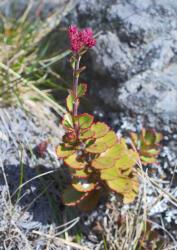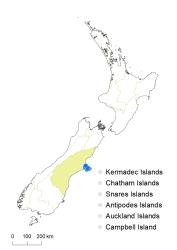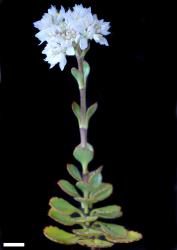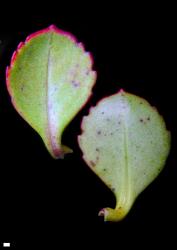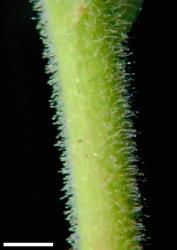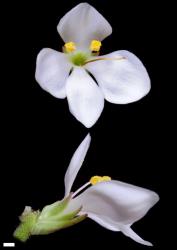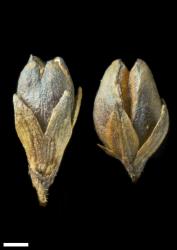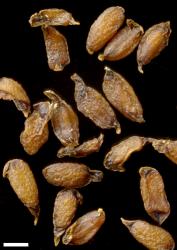- ≡ Hebe lavaudiana (Raoul) Cockayne & Allan, Trans. New Zealand Inst. 57: 44 (1926)
- ≡ Parahebe lavaudiana (Raoul) Heads, Bot. J. Linn. Soc. 115: 83 (1994)
- ≡ Heliohebe lavaudiana (Raoul) Garn.-Jones, New Zealand J. Bot. 34: 427 (1996)
Low shrub to 0.3 m tall. Stems prostrate to ascending, eglandular-pubescent, or sometimes glandular as well; hairs uniform. Leaf bud indistinct; leaves separating while very small, opposite-decussate, spreading to recurved, separating early, coriaceous, obovate to orbicular, 7–30 mm long, 6–17 mm wide, dull dark green to glaucescent above, paler beneath; midrib evident, glabrous; margin glabrous, or glandular- and eglandular-ciliate, crenate or crenate-serrate with 6–10 pairs of teeth; apex obtuse to truncate, sometimes apiculate; base cuneate; petiole 2–8 mm long. Inflorescence a terminal compound spike, 20–150 mm long; flowers crowded, 50–150 per inflorescence, all bisexual; bracts alternate, the lowest opposite, deltoid to narrowly deltoid, = calyx; pedicels absent. Calyx lobes 5, acuminate, equal, 4–5 mm long, sometimes the anterior pair fused ⅔ of length, glandular-ciliate. Corolla 11–13 mm diameter; tube white with greenish-yellow base,1.5–2.0 mm long, < calyx, glabrous; lobes 4, white or pink (pink in bud) erect to spreading, unequal, elliptic to rhomboid or broadly rhomboid, 4.5–5.5 mm long, sub-acute; nectar guides absent. Stamen filaments white, 2.5 mm long; anthers yellow. Style glabrous, 6–7 mm long. Capsules broadly angustiseptate to turgid, emarginate, glabrous or glandular-hairy at apex, 3–4 mm long, 2.0–2.5 mm at widest point. Seeds obovoid or fusiform, weakly flattened, winged, weakly rugulose on back, pale brown, 1.7–2.7 mm long.
V. lavaudiana belongs to the distinctive sun hebe group, which is characterised by toothed or crenate leaves, terminal paniculate inflorescences, style very much > stamens, ciliate nectarial disc, and fusiform seeds. Within this grouping it is distinguished by its dull, crenate leaves, crowded white flowers with pink buds, acuminate calyx lobes, and glandular-hairy inflorescences. The leaves often have red margins.
South Island: Canterbury (Port Hills and Banks Peninsula only).
Basalt outcrops and cliffs, generally confined to places out of reach of browsing mammals. Recorded elevations range from 152 to 809 m.
V. lavaudiana does not grow together with any closely related species, but hybridises in cultivation with V. hulkeana (=V. ×fairfieldii Hook.f., Garnock-Jones 2008).
Flowers: October–January; fruits: January–March.
2n = 42 (Hair 1967, as Hebe lavaudiana).
Veronica lavaudiana is classified in V. subg. Pseudoveronica sect. Hebe and informally in the “sun hebe” group (Albach & Meudt 2010). Monophyly of the sun hebe clade is firmly established (Albach & Meudt 2010), and this small clade is probably related to the speedwell hebe clade (formerly Parahebe p.p. and V. macrantha).
The leaves have dense stomata on both surfaces, but these are absent from the margins. The rounded teeth each have a sunken hydathode at the tip.



